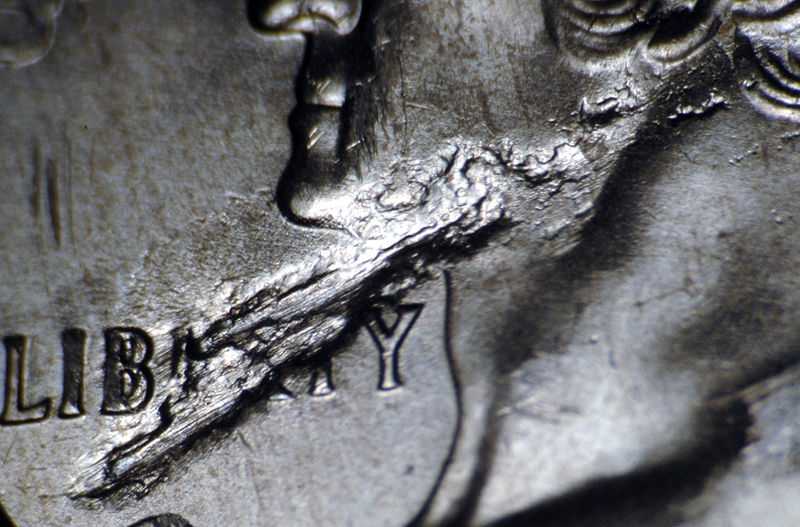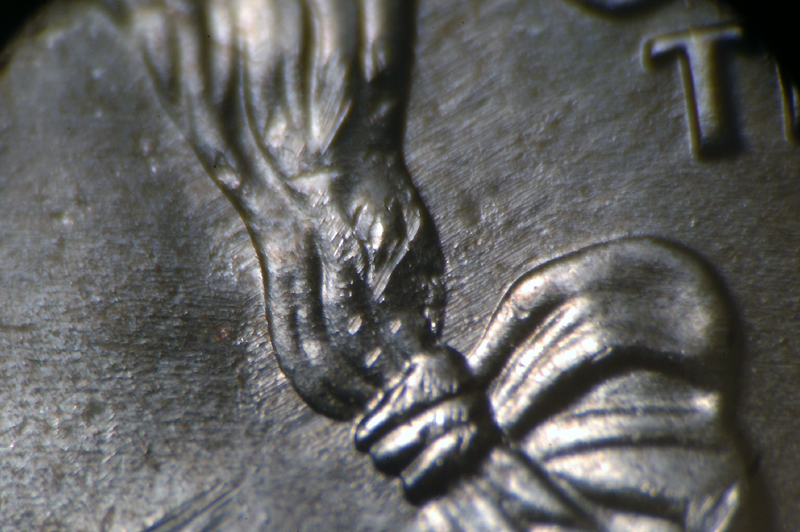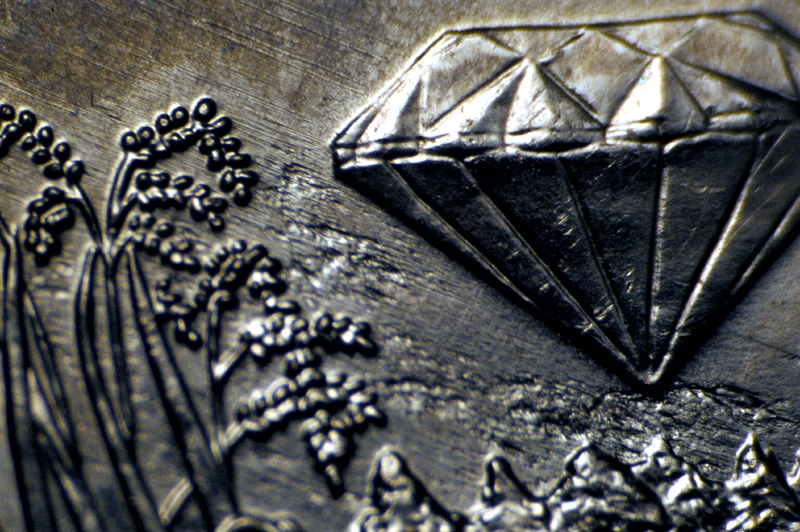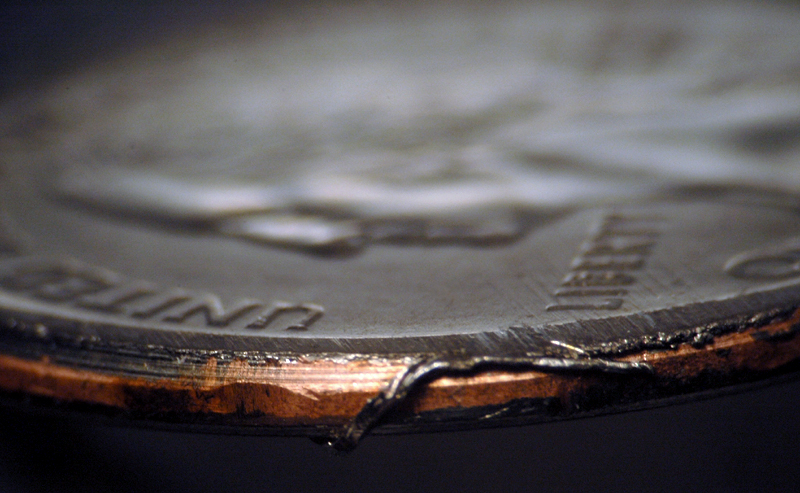
Arrows point to the die breaks and clash marks on Hand's New Mexico State quarter.
New
Mexico & Arkansas Quarters Sport Errors
Ken
Potter
Special to: Numismatic News
7/5/2008
Richard Hand of MA sent Numismatic News a 2008-P New Mexico State quarter that exhibits die breaks. They show as two fairly large breaks along the northern border of the topographical outline of the State on either side of the Zia Pueblo sun symbol. There are also other aberrations in the area in the form of high and low spots further to the left and on the upper right side of the state. Other deformities show even lower that are not illustrated here.
The variations appear to be a combination of some light die clash marks and die breaks. The die breaks most probably formed from out of areas that began as clashes. The clash marks weakened the die steel and areas of metal conforming to the shape of these marks eventually broke away and formed into the die breaks we see here.
A die clash occurs when the planchet delivery system fails to deposit a planchet within the dies and they cycle and smash or clash into each other. When this occurs the design of one or both dies may impart outlines and other deformities to each other. Coins struck with these dies will normally show these aberrations until they are removed by the Mint or wear away. In this case, as we can see, clashes may progress and be literally replaced by die breaks.
Because they are so prolific, most die clashes, die breaks, die cracks, etc., are generally considered minor and carry little if any numismatic premium. Nonetheless, they are fun to find and collect. They are also educational in that they are just one aspect of the study of the minting process and the errors and varieties that may result from it. Many advanced error-variety specialists started with these minors and on occasion many of them still set a few to the side just to have one or two for posterities sake.
Philip Buttermore of PA sent in a very interesting Strike-Through error on a 2008-P New Mexico quarter. The strike-through is displayed on the obverse as a deep trench that runs diagonally from the central region of Washington’s neck and through the word LIBERTY. One of the interesting characteristics of this coin is the pattern of parallel scrape marks that appear in the recesses of the strike-through. Microscopic examination suggests that this is not damage to the coin but rather damage imparted to the offending object that was struck into the coin. When we look further we also see a series of parallel lines in low areas of the portrait with the strongest above and bordering either side of the queue in Washington’s hair. These die lines exhibit characteristics that some error-variety specialists attribute to a die that has had some of its high points scraped by a feeder/ejector mechanism. The low spots on the coin would, of course, be the high spots on the die.
While the parallel die scrape marks transferred to the coin from the struck-through object and the lines cut into the die may at first seem unrelated there is a smoking gun. When we take another look, we see that the coin itself has suffered from post-strike damage in the form of a series of scrape marks on many of the high points of the obverse of the coin. These marks are, pure and simple; damage to the coin that occurred after the coin was struck, albeit may have occurred within a split second after struck as it was being ejected from the press.
In effect, it appears that a feeder/ejector mechanism and the coining cycle was out of synchronization and was scraping and causing damage not only to the die but also to at least some of the coins just before or as they were being ejected from the press. The offending metal that was struck into this coin was a result of that process as it was probably scrap that was scraped away from a coin that was struck earlier (or even scraped from peripheral tooling) and then deposited into the dies to create this error. If the offending material adhered to the die for a sequence of strikes then other similar pieces will exist. In fact Buttermore reported to Numismatic News by phone, finding two other examples after this one was sent in described as being in different stages.
I must point out that there could have been problems with the collar or die set up that may have originally thrown the system out of sync and created the damaged die/coin scenario that resulted from the feeder/ejection system. So while we may be able to suggest that the feeder/ejector mechanism is the most probable direct cause of the strike-through and other problems with this coin, we cannot suggest what may have originally been the source of that breakdown.
I can make this statement with at
least a bit of authority as several years ago, error dealer, Fred Weinberg of
Encino, CA sent 59 examples of 2003-P Arkansas State quarters for study.
The coins all exhibited die damage to the obverse and reverse as a series
of parallel die lines that run in the same direction (on both sides of the coin)
that a number of post-strike scrapes ran on the obverse of many of the coins.
In fact the lines from each cause converge into each other so perfectly that it
is impossible to tell by looking at photos alone were the lines from the damage
end and the die lines start. This uniform directionality of the scrapes
confirms their source as
almost undoubtedly one and the same. The
coins also exhibited areas that appeared as strike-through recesses on the
reverse where metal from the scraped coins and/or die had piled up and adhered
to the die for a sequence of many very similar but often distinctly different strikes.
Additionally, all the coins exhibited strong Titled Partial Collar Strikes
meaning that the collar was out of position during the strike resulting in the
coins containing virtually no reeding around much of their circumference.
For tilted partial collars to occur during the strike and exist in
combination with the other problems that seemed to occur to the dies and coins
between strikes strongly suggests there is a relationship. Of course, it could have been the feeder/ejector system that
caused the collar problem and not visa versa. So the question is:
Which came first, the chicken or the egg? We may never know other than one probably caused the other.
Ken Potter is the official attributer of world doubled dies for the Combined Organizations of Numismatic Error Collectors of America and for the National Collectors Association of Die Doubling. He also privately lists other collectable variety types on both U.S. and world coins in the Variety Coin Register. He is a regular columnist in Numismatic News’ sister publication, World Coin News, were he pens the Visiting Varieties column. More information on either of the clubs or how to get a coin listed in the Variety Coin Register may be obtained by sending a long self addressed envelope with $1 postage to P.O. Box 33, Pinckney, MI 48169 or by contacting him via email at KPotter256@aol.com. An educational image gallery may be viewed on his website at www.koinpro.tripod.com.

Arrows point to the die breaks and clash marks on Hand's New Mexico State
quarter.

Phillip Buttermore sent in this 2008-P New Mexico State quarter with a
Strike-through error on the obverse.

Buttermore's quarter also shows die scrape marks around and above the queue in
Washington's hair.

Buttermore's coin also shows post-strike damage in the form or scrapes that may
be related to the process that cause the die scrapes and even the
strike-through error.

Obverse of Buttermore's coin.

Here is a look at one of Fred Weinberg's 2003-P Arkansas State quarters with die
scraps emanating from the upper left of the diamond and converging with
the strike-through area below. A barely hanging piece of long wire-like
scrap can be seen at the left rim. It is the result of something scraping
the obverse of the coin.

A closer look at the die scrape lines and strike-through areas on Weinberg's
coin.

Here is a look at the obverse of Weinberg's coin showing how the die scrape
marks run perfectly parallel to and converge with the post-strike damage that
runs from the rim and through portions of LIBERTY.

Here we see another of Weinberg's coins. Notice that the die scrapes,
(most easily differentiated from the damage by looking at those lines closest to
Washington's chin), are exactly like those shown on the previous coin while the
post-strike damage emanating from the rim area is far more extensive than on the
previous coin.

A side view of one of Weinberg's coins showing the titled partial collar strike
(in an area where there is no reeding) and the hanging sliver of metal.

The obverse and reverse of Weinberg's coin.
https://koinpro.tripod.com/cgi-bin/KPHeader.jpg